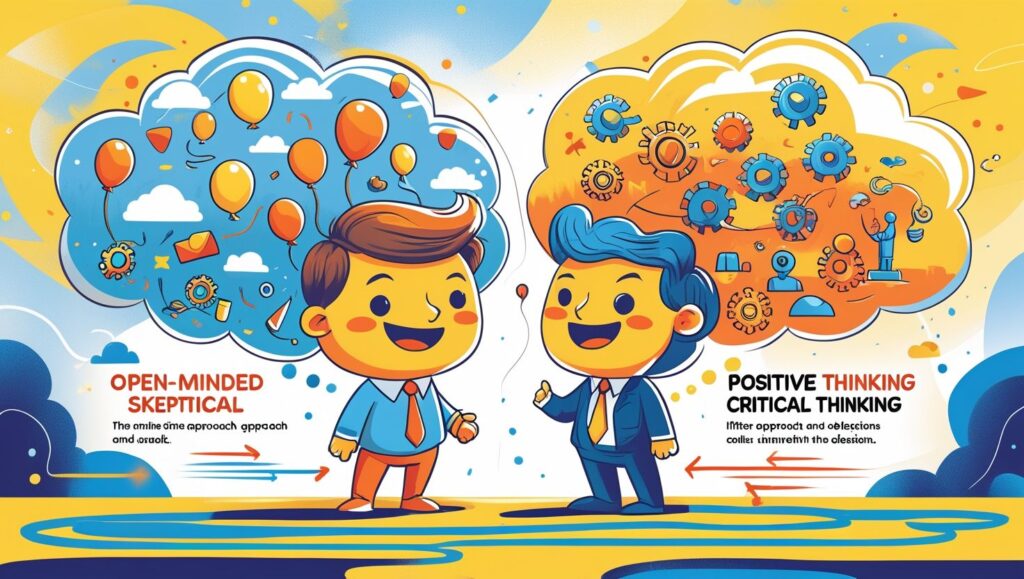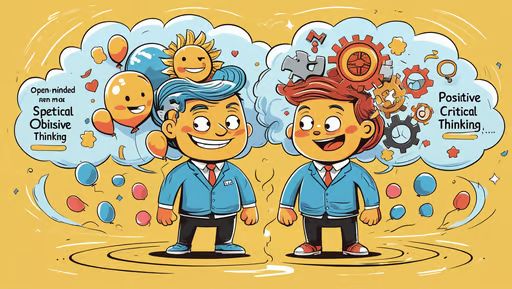Positive Thinking vs. Critical Thinking, In the realm of personal and professional development, two cognitive approaches often take center stage: positive thinking and critical thinking. While both are essential for growth, they serve different purposes and can sometimes appear to be at odds with one another. Positive thinking emphasizes optimism, hope, and focusing on the bright side of life, while critical thinking involves analyzing, evaluating, and questioning information to make informed decisions. Understanding the strengths and limitations of each approach, as well as how to balance them, is key to achieving success and fulfillment in life.
What is Positive Thinking?
Positive thinking is a mental attitude that focuses on expecting good outcomes, maintaining an optimistic outlook, and approaching challenges with a can-do mindset. It is rooted in the belief that our thoughts shape our reality, and by focusing on positive outcomes, we can attract success and happiness. This approach has gained significant popularity through movements like the Law of Attraction and self-help literature, which emphasize the power of optimism.
Benefits of Positive Thinking
- Improved Mental Health: Positive thinking is associated with reduced stress, anxiety, and depression. By focusing on the good, individuals can cultivate resilience and emotional well-being.
- Enhanced Motivation: Optimism fuels motivation and perseverance. When people believe in their ability to succeed, they are more likely to take action and overcome obstacles.
- Better Relationships: A positive attitude fosters empathy, kindness, and cooperation, which can strengthen personal and professional relationships.
- Physical Health Benefits: Studies have shown that positive thinkers tend to have better cardiovascular health, stronger immune systems, and longer lifespans.
Limitations of Positive Thinking
While positive thinking has many benefits, it is not a cure-all solution. Over-reliance on optimism can lead to:
- Denial of Reality: Ignoring problems or challenges in favor of maintaining a positive outlook can prevent individuals from addressing issues effectively.
- Unrealistic Expectations: Excessive optimism can lead to disappointment when outcomes do not match expectations.
- Avoidance of Critical Analysis: Positive thinking alone does not encourage questioning or evaluating situations, which can result in poor decision-making.
What is Critical Thinking?
Critical thinking is a disciplined process of actively analyzing, synthesizing, and evaluating information to reach a well-reasoned conclusion. It involves questioning assumptions, identifying biases, and considering multiple perspectives before making decisions. Critical thinkers are skeptical, logical, and objective, striving to separate fact from opinion.
Benefits of Critical Thinking
- Better Decision-Making: By evaluating evidence and considering alternatives, critical thinkers make informed and rational decisions.
- Problem-Solving Skills: Critical thinking enables individuals to break down complex problems, identify root causes, and develop effective solutions.
- Enhanced Creativity: Questioning assumptions and exploring different perspectives can lead to innovative ideas and approaches.
- Reduced Errors: Critical thinking minimizes the risk of errors and biases, leading to more accurate conclusions.

Limitations of Critical Thinking
While critical thinking is invaluable, it also has its drawbacks:
- Over-Analysis: Excessive scrutiny can lead to “analysis paralysis,” where individuals struggle to make decisions due to overthinking.
- Negativity Bias: Critical thinkers may focus too much on potential flaws or risks, leading to pessimism or cynicism.
- Emotional Detachment: Over-reliance on logic and objectivity can sometimes result in a lack of empathy or emotional connection.
Positive Thinking vs. Critical Thinking: Key Differences
The primary difference between positive thinking and critical thinking lies in their focus and approach. Positive thinking is emotion-driven and future-oriented, emphasizing hope and optimism. Critical thinking, on the other hand, is logic-driven and present-oriented, emphasizing analysis and evaluation.
For example, imagine a person starting a new business. A positive thinker might focus on the potential for success, visualizing a thriving company and feeling motivated by the possibilities. A critical thinker, however, would analyze market trends, assess risks, and develop a detailed business plan to mitigate challenges.
While these approaches may seem contradictory, they are not mutually exclusive. In fact, combining the strengths of both can lead to a more balanced and effective mindset.
The Power of Balancing Positive and Critical Thinking
The key to maximizing the benefits of both positive and critical thinking lies in finding a balance. Here’s how:
- Use Positive Thinking to Fuel Motivation: Optimism can inspire action and resilience, helping individuals stay motivated in the face of challenges. For instance, a positive thinker might view a setback as a learning opportunity rather than a failure.
- Apply Critical Thinking to Evaluate Reality: Critical thinking ensures that decisions are based on evidence and logic rather than wishful thinking. It helps individuals identify potential pitfalls and develop strategies to address them.
- Combine Both for Effective Problem-Solving: When faced with a problem, start by brainstorming positive outcomes (positive thinking) and then critically evaluate the feasibility of each option (critical thinking). This approach encourages creativity while maintaining practicality.
- Adapt to the Situation: Different situations call for different approaches. In high-stakes scenarios, critical thinking may take precedence, while in personal relationships, positive thinking can foster harmony and understanding.
Real-Life Applications
- Career Development: In the workplace, positive thinking can boost morale and productivity, while critical thinking ensures that projects are well-planned and executed. For example, a team leader might use positive thinking to motivate their team and critical thinking to identify potential risks in a project timeline.
- Personal Relationships: Positive thinking can help maintain harmony and resolve conflicts, while critical thinking can address underlying issues and improve communication. For instance, a couple might use positive thinking to focus on their shared goals and critical thinking to address specific challenges in their relationship.
- Health and Wellness: Positive thinking can improve mental and physical health by reducing stress and promoting a sense of well-being. Critical thinking, on the other hand, can help individuals make informed decisions about their health, such as evaluating the credibility of a new diet or treatment.
Potential Pitfalls to Avoid
- Overemphasis on Positive Thinking: Ignoring problems or dismissing valid concerns in favor of maintaining a positive attitude can lead to poor decision-making and unresolved issues.
- Overemphasis on Critical Thinking: Constantly analyzing and questioning can lead to stress, anxiety, and a lack of spontaneity. It’s important to know when to step back and trust your instincts.
- Failure to Integrate Both Approaches: Relying solely on one approach limits your ability to navigate complex situations effectively. Strive to integrate both positive and critical thinking for a well-rounded perspective.
Conclusion
Positive thinking and critical thinking are both valuable tools that serve different purposes. Positive thinking fosters optimism, motivation, and emotional well-being, while critical thinking promotes logic, analysis, and informed decision-making. Rather than viewing them as opposing forces, it’s important to recognize their complementary nature.
By striking a balance between the two, individuals can harness the power of optimism while remaining grounded in reality. Whether in personal relationships, career development, or health and wellness, integrating positive and critical thinking can lead to greater success, fulfillment, and resilience. Ultimately, the ability to adapt and apply the right mindset to the right situation is the hallmark of a well-rounded and effective thinker.

3 thoughts on “Positive Thinking vs. Critical Thinking”
Comments are closed.